If you are starting to plan your new kitchen, this step-by-step guide to all the elements you need to consider is a must read. You are already one step closer to your perfect kitchen.
Planning a kitchen design that works for your home is an important and exciting process. Pinterest, mood boards, paint swatches, material samples, flicking through magazines and brochures and visiting showrooms, are all good fun but it can start to get overwhelming very quickly. That’s where our guide can help you and keep the process enjoyable.

Whether you are planning to splash the cash or sticking to a tight budget, this article will make sure your design is the right one for you and your lifestyle. We will help you choose all the elements to create your dream kitchen, including, of course, the ideal floor for your space.
Gone are the days when kitchens were hidden away, they have become the heart of the home and where we spend a lot of time. They are no longer just food preparation areas, but multi-functional spaces that need to be flexible and look good enough to welcome visitors. The aim is to create a space that is both stylish and practical.
Here are our six simple steps to create that dream kitchen:
1. List the must-have elements for your kitchen
To do this, start by looking at your current kitchen; what features do you need to bring through to your new kitchen, what would you like to lose, and what new elements would you like to add?
Do you have enough storage? What appliances do you want to incorporate?
2. Plan your layout
There will be an infinite number of possible combinations, so to do this ask yourself a few questions:
- What are the functions of your space?
- Is your kitchen part of an open-plan space?
- Can you create the ideal ergonomic triangle between your cooker, sink and fridge?
- What shape will your units make? U-shape? Galley? L-shape? Or maybe a design including an island?
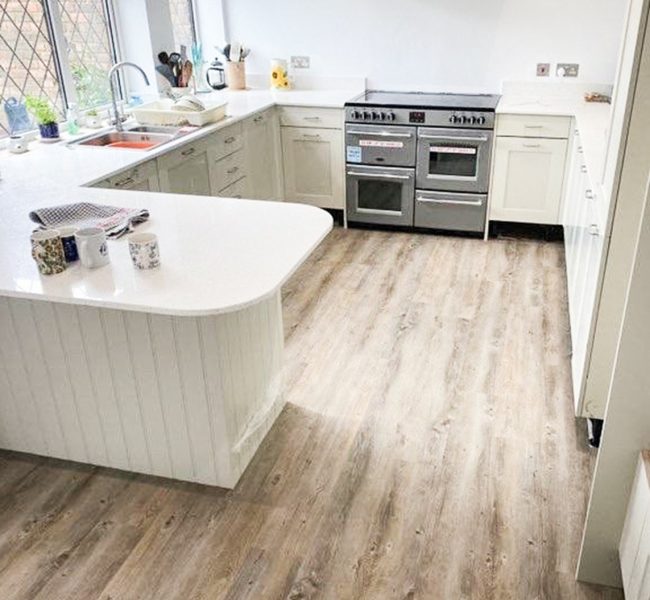
3. Draw out your plan
If you are handy with a pencil, ruler and a bit of graph paper, measure and make a scale plan of your room, marking out all fixed elements, like doors and windows, then cut out shapes of the appliances and cabinets you want and move them around your room until you have the layout that works best for you. Alternatively, have a look at online kitchen design tools. IKEA has a great free design tool, even if you don’t plan to buy an IKEA kitchen it is a good place to start. Or you can simply search for 3D room planners and many apps and online tools will come up. Find one that you find easy to use and get stuck in.
If on the other hand, you are not confident in doing the design yourself, take your lists from steps 1 and 2 into a few different kitchen show rooms and ask them to map out some options for you.
4. Discover the design elements that you love
Whether you like flicking through magazines or searching online, now is the time to gather all your favourite kitchen design ideas in one place. If online is your preference, then Pinterest is an excellent tool for grouping your ideas together. If you prefer brochures and magazines, then don’t be afraid to cut/rip out pictures you like so that you can see them all next to each other. Being able to view them like this will allow you to identify the common elements across all the images, so that you know what your design preferences are. Are all your images bright and light? Or are they more dark and moody? Are you looking for a modern design or a more traditional feel? You will soon see which direction your design is heading.



5. Define your materials
So, you know the overall look and feel that you like, and you know what you need in your space. Both will allow you to make the right choices when it comes to materials. Be guided by your scrapbook of images as you make your choices, keep looking back to them, it’s easy to veer off on another path without regular reminders. There are a few key elements you need to choose to pull your kitchen design together:
- Worktops – are you going to choose wood, granite, marble, laminate, or composite? What colour? Is it going to be light or dark?
- Cabinetry – are you going to choose solid wood cabinets or MDF?
- Wall protection – will you have tiles? Glass splashbacks? Upstands? Or maybe a combination of two or more of these?
- Paint colours – you have your walls, ceiling and possibly cabinets to consider too. Refer to the images you have selected and get those paint charts out. Some paint companies offer colour consultations. If you feel you need help, ask for it.
- Lighting – where will you want your lighting? How do you want to be able to control it? Think about ambient, accent and task lighting in your space.
- Window dressings – Maybe shutters or blinds? Or maybe nothing at all? Do you need privacy? Make sure your choice is easy to keep clean.
- Flooring – last but by no means least, your flooring choice. Which of course, is where our interest in kitchen design comes in. So, please allow us to take a bit of time to go into this part of the process in more detail…
In our experience, flooring is often a last-minute choice when it comes to design, and if you think about how much visual space flooring takes up in a room, you’ll quickly realise that your flooring choice is instrumental in how your design comes together. Go back and look at the images of kitchens that you like, now look at the floors. You will see that they work with the overall design. You may choose to match the tone of your floor to your worktop, or you may use your floor to make a contrasting design choice by adding in some pattern to an otherwise simple kitchen, or it could be your chance to emphasise your design preference by choosing a traditional material to complement your traditional cabinetry. Whatever you choose in style, there are some key things to consider when choosing the material for your flooring. It is important that your new floor is going to stand up to all that a busy kitchen will throw at (or should that be drop on) it. It needs to be hardwearing; it needs to look good; it needs to be easy to clean; it needs to withstand spills, condensation, splashes and maybe even leaks; and it needs to cope with temperature changes.
Here is a quick run through of your options:
- Tiles – you can choose from man-made or natural materials. The important things to avoid here is porous materials such as travertine and limestone which scratches easily.
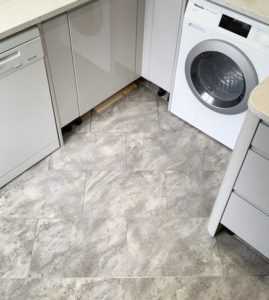
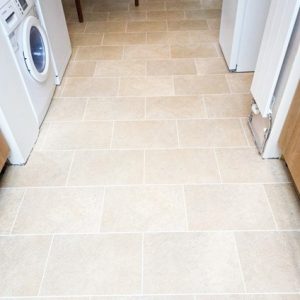
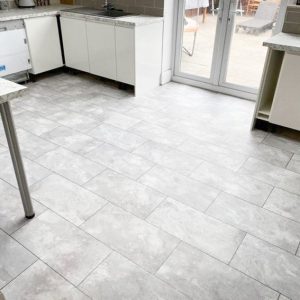
- Wood – we would not recommend solid wood for a kitchen floor, it just won’t stand up to the heat and moisture changes that a kitchen is subject to. Engineered wood is a possible option, but if you want a wood-look floor our recommendation for a kitchen would be to choose a Luxury Vinyl plank, which brings us to…




- Luxury Vinyl Flooring – this is probably our top pick for kitchen floors. Whether you are looking for a stone, ceramic or wood design for your floor, there is a LVT (Luxury Vinyl Tile) for you. Every colour of wood, lots of detail or very little, polished ceramic looks and natural stone finishes, they are all available. They can be laid in different patterns to add interest, with boarders or design strips.
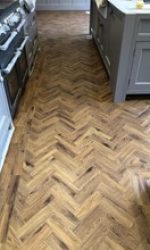


- Rubber – if you are looking for a contemporary, practical kitchen floor, then you might want to consider a rubber floor.
- Concrete – have you ever seen freshly poured perfect concrete? If so, you will understand the trend for polished concrete floors. There is something extremely appealing about the finish. And of course, it is a really practical choice too.
There really is a lot of choice so if you still feel a bit unsure about your flooring choice, just give us a call (on 01202 699388) or email us and we can help you talk through your design and requirements.
6. Find your tradespeople
From kitchen fitters, to electricians, from plumbers to floor fitters, you will need to find the people with the skills to implement your vision. This can be a daunting process, but the best way to get started is to talk to people. Have a look at reviews on Checkatrade and other similar websites. If you get talking with a tradesperson, you will soon get a feel for whether they are the right person for you. And a great way to find your other trades is to ask your existing ones. Find out who they like to work with and who the recommend. Make sure anyone you choose has the required certifications, this is particularly important when employing an electrician or a plumber who will be installing gas appliances.

